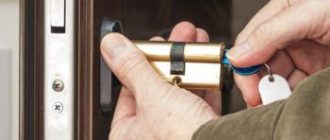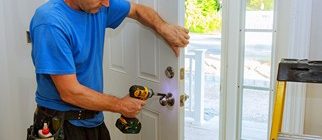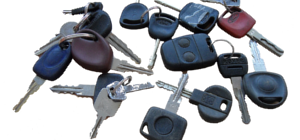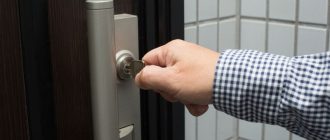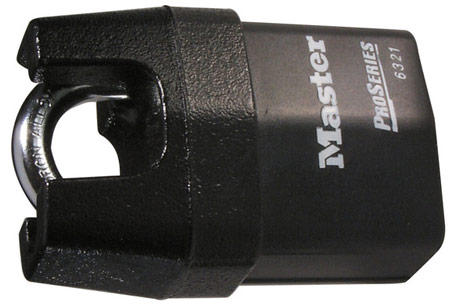
A Tampered With Lock
Lock tampering is a serious concern for homeowners and business owners alike. A tampered lock can compromise the security of your property and leave you vulnerable to theft or intrusion. It is important to be able to recognize the signs of tampering and take steps to prevent it.
One of the most obvious signs that a lock has been tampered with is physical damage. If you notice scratches, dents, or other signs of forced entry around your lock, it is likely that someone has been attempting to pick or break the lock. Additionally, if your lock is no longer functioning properly or feels loose, it may have been tampered with.
Another sign of tampering is the presence of foreign objects in the lock. Burglars may use tools or other objects to try and manipulate the lock mechanism. If you discover anything unusual or unexpected in your lock, such as bits of metal or plastic, it is a clear sign that someone has been tampering with it.
To prevent lock tampering, there are several steps you can take. First, choose high-quality locks that are difficult to pick or break. Look for locks that are made of sturdy materials and have additional security features, such as anti-pick pins or reinforced strike plates. It is also a good idea to install a deadbolt lock in addition to a standard lock for added security.
In addition to choosing secure locks, it is important to properly maintain them. Regularly inspect your locks for signs of tampering or damage and replace them if necessary. Reinforce the door and frame with additional security measures, such as a door jamb reinforcement plate or a security bar. Finally, consider installing a security system with cameras to deter potential burglars and provide evidence in case of a break-in.
Recognizing Signs of Tampering
When dealing with a lock, it’s important to be aware of any signs that it may have been tampered with. Here are some common indicators to look out for:
1. Scratches or damages: Check the surface of the lock for any scratches, dents, or other signs of physical damage. These could be an indication that someone has attempted to force the lock open.
2. Misalignment: If the lock appears to be misaligned or crooked, it may have been tampered with. A lock that has been tampered with may not function properly and may be easier to pick or manipulate.
3. Loose or missing parts: Take a close look at the lock and make sure all parts are intact and securely in place. Loose or missing parts could be a sign of tampering, as someone may have tampered with the lock to gain access.
4. Unusual residue or marks: Look for any unusual residue or marks on the lock. This could be a sign that someone has used tools or chemicals to manipulate the lock.
5. Evidence of picking: If there are any visible marks or damage on the lock mechanism, it could be a sign that someone has attempted to pick the lock. Look for scratches, bent pins, or other signs of manipulation.
Preventing tampering: To prevent tampering with a lock, it’s important to choose a high-quality lock that is difficult to pick or manipulate. Regularly inspect the lock for any signs of tampering, and consider installing security cameras or alarms to deter potential tampering.
Common Methods of Lock Tampering
Tampering with locks is a serious security threat that can leave your property vulnerable to unauthorized access. There are various methods that criminals use to tamper with locks, each with its own signs and preventive measures. By understanding these methods, you can better protect your property and ensure the safety of your belongings.
| Bumping | Indentations or scratches on the keyhole, misalignment of the pins, loose or missing screws | Install bump-resistant locks, use security pins, or upgrade to electronic locks |
| Picking | Lock picking tools, scratched or damaged lock, pins in unusual positions | Install pick-resistant locks, use high-security cylinders, or add a secondary lock |
| Drilling | Splintered or damaged lock, metal shavings around the keyhole, misplaced or broken pins | Use anti-drill plates, install hardened steel locks, or add a security bar |
| Impressioning | Signs of forced entry, scratches or marks on the key, misshapen or damaged pins | Upgrade to bump-resistant or pick-resistant locks, use restricted key systems |
| Key Duplication | Unexplained key duplicates, keys that don’t fit the lock properly, signs of forced entry | Use restricted key systems, control key distribution, regularly change locks or rekey them |
By being aware of these common methods of lock tampering, you can take appropriate measures to protect your property. It is advisable to consult a professional locksmith for further guidance on securing your locks and implementing effective security measures.
Scratches and Physical Damage
One of the signs that a lock has been tampered with is the presence of scratches and physical damage on the lock itself. These marks can indicate that someone has tried to manipulate or force the lock open using various tools or methods.
Scratches and physical damage can occur due to picking attempts, using improper tools, or applying excessive force on the lock. The presence of these marks suggests that the lock has been tampered with and compromised.
To prevent scratches and physical damage on locks, it is important to handle them with care and use the right tools when necessary. Avoid using excessive force when operating a lock, as it can result in damage. Additionally, consider installing protective measures such as security cameras or alarm systems to deter potential tampering.
Regularly inspecting your locks for scratches and physical damage is also recommended. By doing so, you can identify any signs of tampering early on and take appropriate actions to rectify the situation.
Misalignment and Loose Components
One of the signs that a lock has been tampered with is misalignment. Misalignment occurs when the lock’s internal components are not properly aligned, causing the lock to be difficult to open or close. This can be caused by various factors, including incorrect installation, rough use, or attempted break-ins.
Another sign of tampering is loose components. When a lock has been tampered with, the internal components may become loose or dislodged. This can cause the lock to malfunction or become completely unusable. Loose components can be identified by rattling or unusual movements when the lock is being operated.
To prevent misalignment and loose components, it is important to ensure that locks are installed correctly and maintained regularly. Regular inspections and maintenance checks can help identify any signs of tampering or misalignment early on. Additionally, using high-quality locks and security systems can help deter tampering attempts and provide added protection for your property.
| Misalignment | Correct installation and regular maintenance |
| Loose components | Regular inspections and high-quality locks |
Unusual Noise or Resistance
If your lock has been tampered with, you may notice unusual noise or resistance when inserting or turning the key. This can be an indication that someone has attempted to force the lock or manipulate it using unauthorized tools.
When a lock is tampered with, the internal components may become misaligned or damaged, resulting in a lock that no longer operates smoothly. This can manifest as a scraping or grinding noise when inserting the key or difficulty in turning the key.
If you encounter unusual noise or resistance when operating your lock, it is important to investigate further. First, check if there is any visible damage or signs of forced entry around the lock. Look for scratches, dents, or any other irregularities that may indicate tampering.
Additionally, pay attention to any changes in the lock’s behavior. If it suddenly becomes more difficult to unlock or if the key doesn’t fit as smoothly as before, it could be a sign that someone has tampered with the lock.
To prevent tampering, it is essential to use high-quality locks that are resistant to picking, bumping, and drilling. Consider installing additional security measures such as deadbolts or security strike plates to reinforce the strength of your locks.
In conclusion, experiencing unusual noise or resistance when operating your lock can be a clear sign that it has been tampered with. Regularly inspect your locks for any signs of damage or forced entry, and invest in high-quality locks to enhance your home’s security.
Keyway Manipulation
Keyway manipulation is a common method used by intruders to tamper with a lock. This technique involves manipulating the keyway, which is the part of a lock where the key is inserted, in order to bypass the lock’s mechanisms and gain unauthorized access.
There are several signs to look out for that indicate keyway manipulation. These include:
- Scratches or damage to the keyway: If you notice any scratches or other damage to the keyway, it could be a sign that someone has been trying to manipulate the lock.
- Slight misalignment of the keyway: If the keyway appears slightly misaligned or crooked, it may indicate that someone has been attempting to manipulate it.
- Unusual resistance or difficulty when inserting the key: If you experience unusual resistance or difficulty when inserting the key into the lock, it could be a sign of keyway manipulation.
To prevent keyway manipulation, there are a few steps you can take:
- Install a lock with a high-security keyway: High-security keyways are designed to be more resistant to manipulation, making it harder for intruders to tamper with the lock.
- Use restricted key systems: Restricted key systems use keys that cannot be easily duplicated without authorization. This helps reduce the risk of unauthorized individuals attempting keyway manipulation.
- Maintain regular lock maintenance: Regularly inspect and maintain your locks to ensure they are in good working order and to detect any signs of tampering or manipulation.
By being aware of the signs of keyway manipulation and taking preventative measures, you can help protect your property and increase the security of your locks.
Picking and Bumping
One of the most common ways that a lock can be tampered with is through picking and bumping. These methods involve manipulating the components of the lock to gain unauthorized access.
Picking a lock typically involves using special tools, such as lock picks or tension wrenches, to manipulate the pins or tumblers inside the lock. By applying the right amount of pressure and carefully moving the pins, a skilled individual can unlock the lock without the proper key.
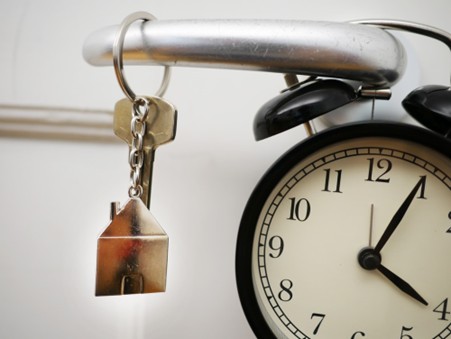
Bumping a lock is a similar technique that uses a specially crafted bump key. This key is inserted into the lock and then struck with a blunt object, causing the pins to momentarily jump and allowing the lock to be turned open.
Both picking and bumping are considered covert methods of entry, as they leave little to no visible signs of tampering. This makes them particularly concerning for homeowners and businesses alike.
To prevent picking and bumping, it is important to choose high-quality locks that are resistant to these techniques. Look for locks that have a high security rating and feature anti-pick and anti-bump mechanisms.
In addition, it is recommended to use additional security measures, such as installing security cameras or alarm systems, to deter potential intruders. Regularly inspect the locks for signs of tampering, such as scratches or other damage, and promptly replace any compromised locks.
| Picking | Bumping |
| Manipulates pins or tumblers inside the lock | Uses a specially crafted bump key |
| Requires special tools and skill | Can be done with a bump key and a blunt object |
| Leaves little to no visible signs of tampering | Also leaves little to no visible signs of tampering |
Drilling and Breaking
When a lock has been tampered with, one of the most common methods used is drilling. The perpetrator may drill into the lock cylinder or the door itself in order to bypass the lock mechanism. This method is often used because it can be quick and relatively quiet.
Signs of drilling can usually be seen by inspecting the lock. There may be visible holes or marks on the lock cylinder where the drilling occurred. Additionally, there might be metal shavings or residue around the drilled area.
Another method of tampering is breaking the lock. This involves using force to manipulate or break the lock mechanism, rendering it inoperable. There may be visible signs of forced entry, such as bent or broken lock components.
To prevent drilling and breaking, it is recommended to install high-security locks that are resistant to these methods. These locks are designed with reinforced components and extra security features that make them difficult to tamper with. Additionally, it is important to ensure that doors and frames are made of sturdy materials that can withstand forceful entry attempts.
In conclusion, drilling and breaking are common methods of tampering with locks. By being aware of the signs of tampering and taking preventive measures, you can increase the security of your locks and protect your property from unauthorized access.
Preventing Lock Tampering
Protecting your locks from being tampered with is essential for ensuring the security of your property. Here are some tips on how to prevent lock tampering:
1. Choose high-quality locks: Invest in a good lock that is difficult to pick or bypass. Look for locks that have been tested and rated by trusted certification organizations.
2. Install a deadbolt lock: Deadbolt locks provide an additional layer of security compared to regular spring-lock mechanisms. Make sure to install a deadbolt lock on every exterior door.
3. Use security pins: Consider installing security pins in your locks. These pins are designed to make picking or tampering with the lock more challenging.
4. Install a security camera: Placing security cameras near your locks can deter potential intruders and help you track any suspicious activity.
5. Strengthen door frames: Reinforce your door frames with metal plates or strike plates to prevent forcible entry.
6. Regularly maintain your locks: Keep your locks in good working condition by cleaning and lubricating them regularly. This can help prevent any issues that may make the lock more susceptible to tampering.
7. Monitor and control access: Limit the number of people who have access to your property’s locks. Keep track of who has keys to your locks, and consider changing the locks if you suspect any unauthorized access.
By following these preventative measures, you can significantly reduce the risk of your locks being tampered with, ensuring the safety and security of your property.
Choosing High-Quality Locks
When it comes to securing your home or office, choosing a high-quality lock is essential. A well-made lock can provide a strong defense against tampering and ensure the safety of your property.
When selecting a lock, there are several factors to consider. First, look for a lock that is made from durable materials such as solid steel or brass. These materials offer greater resistance to tampering and can withstand attempts to force entry. Additionally, consider the design of the lock. Look for locks with complex mechanisms that are difficult to pick, as this adds an extra layer of protection.
In addition to the lock itself, consider the brand and reputation of the manufacturer. Opt for locks from trusted and established brands, as they are more likely to prioritize quality and security in their products. Research customer reviews and ratings to get a better idea of the reliability and durability of the locks you are considering.
Lastly, consider the type of lock that best suits your needs. There are various types of locks available, including deadbolts, padlocks, and cam locks. The type of lock you choose will depend on factors such as the level of security required and the specific application. For example, a deadbolt lock is often recommended for external doors due to its high level of security.
Overall, investing in high-quality locks is crucial for protecting your property from tampering and potential break-ins. Take the time to research and select locks that meet your specific security needs, and ensure they are installed correctly for maximum effectiveness.
Installing Security Cameras
Installing security cameras can greatly enhance your home or business security and provide you with peace of mind. By monitoring your property 24/7, security cameras can deter criminals and help catch any suspicious activity. Here are some steps to follow when installing security cameras:
- Decide on camera placement: Determine the areas that you want to cover with your security cameras. Choose locations that provide a clear view of the area and consider any blind spots that may need additional coverage.
- Select the right cameras: There are many different types of security cameras available with various features. Consider factors such as resolution, night vision, field of view, and weather resistance when choosing your cameras.
- Mount the cameras: Once you have selected your cameras, securely mount them in the desired locations. Make sure they are positioned at the optimal height and angle for capturing clear footage.
- Run the cables: Connect the cameras to the main recording or monitoring system using appropriate cables. Conceal the cables to prevent tampering and ensure a clean installation.
- Set up the recording system: Install the recording system and configure it according to your preferences. Choose whether you want continuous recording or motion-activated recording, and set up a schedule if needed.
- Test the system: After the installation is complete, test the cameras and recording system to ensure everything is functioning properly. Check the video quality, playback options, and any remote viewing capabilities.
- Maintain and monitor the cameras: Regularly check and clean the cameras to ensure clear footage. Monitor the live feed or review recorded footage regularly to detect any suspicious activity or signs of tampering with your property.
By following these steps, you can install security cameras that will effectively monitor your property and help prevent any tampering or unauthorized access.
Reinforcing Door Frames and Jams
When it comes to protecting your home or business from tampered locks, one important area to focus on is reinforcing the door frames and jams. Door frames and jams can be vulnerable points that allow intruders to gain access if not properly secured.
Here are some steps you can take to reinforce your door frames and jams:
- Install a reinforced strike plate: A strike plate is the metal plate on the door frame where the latch or bolt secures when the door is closed. By replacing the standard strike plate with a reinforced one made of heavy-duty metal, you can make it much more difficult for someone to kick in the door or pry it open.
- Add door frame reinforcements: Door frame reinforcements, such as security plates or metal brackets, can be installed to reinforce the door frame and make it stronger. These reinforcements help distribute the force of impact, making it harder for someone to break through the door.
- Secure door hinges: Hinges are another weak point in a door, as they can be easily tampered with. Consider using hinge pins with set screws or non-removable hinge pins to prevent the door from being easily removed from the frame.
- Use longer screws: Replace the short screws in the door frame and hinges with longer screws that penetrate deeper into the door frame. This provides a stronger anchor, making it harder for the door to be forced open.
- Install a door reinforcement plate: A door reinforcement plate can be installed to reinforce the area around the lock or deadbolt. This additional layer of protection adds strength to the door and makes it more resistant to tampering.
By reinforcing your door frames and jams, you can greatly reduce the chances of a tampered lock leading to a successful break-in. It’s important to invest in these security measures to protect your property and give yourself peace of mind.
Using Additional Security Measures
In addition to a tamper-proof lock, there are other security measures you can take to further enhance the protection of your belongings. These additional measures can help prevent tampering and provide an extra layer of security.
| Surveillance Cameras | Installing surveillance cameras in the vicinity of the lock can deter potential tamperers. These cameras can capture footage of any suspicious activities, which can aid in identifying the culprits. |
| Alarm Systems | An alarm system can be connected to the lock and the surrounding area. If someone tries to tamper with the lock, the alarm will sound, alerting you or a security team to the attempted breach. |
| Access Control Systems | Using access control systems, such as key cards or biometric identification, can limit the number of individuals who have access to the lock. This reduces the chances of tampering by unauthorized individuals. |
| Security Guards | Having security guards on-site can provide a physical presence to deter tampering attempts. They can monitor the lock and its surroundings, ensuring the safety and security of your belongings. |
| Regular Inspections | Regularly inspecting the lock for signs of tampering can help identify any potential security vulnerabilities. Prompt detection and intervention can prevent tampering attempts from being successful. |
By implementing these additional security measures, you can make it more challenging for unauthorized individuals to tamper with your lock. These measures act as a deterrent and provide a proactive approach to protecting your belongings.
Q&A:
What are some signs that a lock has been tampered with?
Signs of tampering with a lock can include scratches or dents on the surface, loose or misaligned parts, and evidence of forced entry such as broken pieces or damaged keyholes.
How can I prevent tampering with my locks?
To prevent tampering with your locks, you can invest in high-security locks with additional features such as bump-proof cylinders and pick-resistant mechanisms. It is also important to regularly inspect your locks for any signs of tampering and promptly replace or repair them if necessary.
What are some common methods used to tamper with locks?
Common methods used to tamper with locks include lock picking, lock bumping, and forced entry techniques such as drilling or breaking the lock.
Can tampered locks be repaired?
In some cases, tampered locks can be repaired if the damage is not too extensive. However, it is often more secure to completely replace the lock to ensure the integrity of your security system.
Are there any advanced security measures I can take to prevent lock tampering?
Yes, there are advanced security measures you can take to prevent lock tampering. This includes installing security cameras and alarm systems, using electronic locks or keyless entry systems, and implementing access control systems to monitor and control entry to your property.

